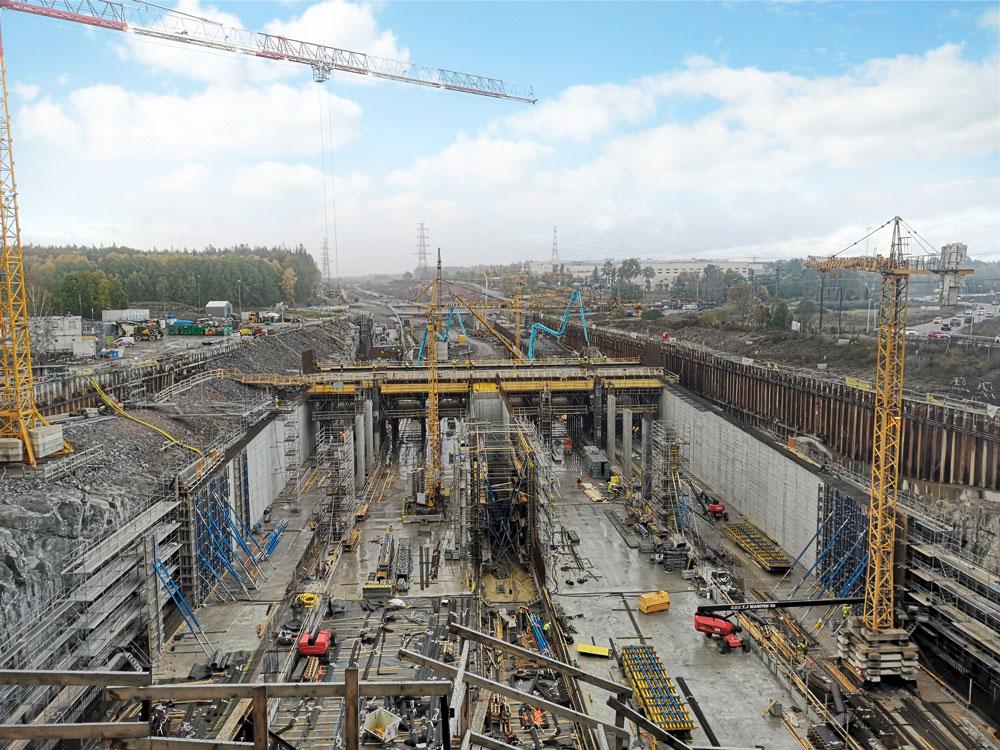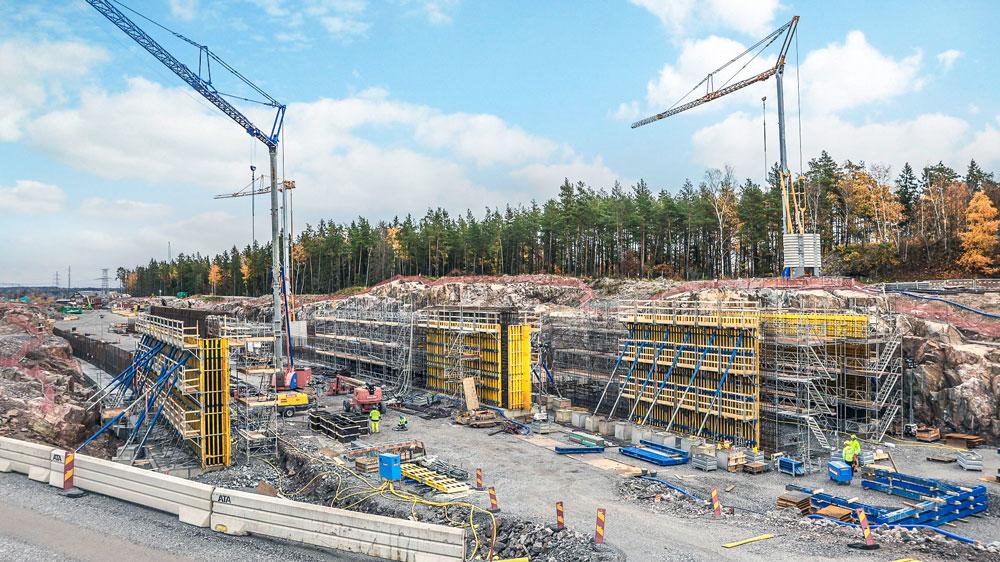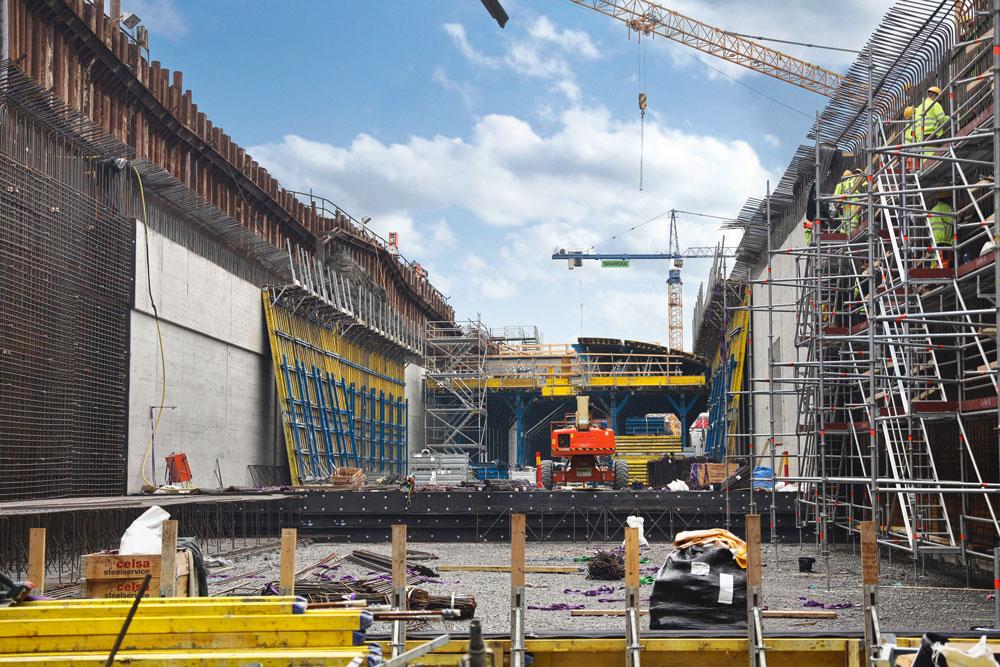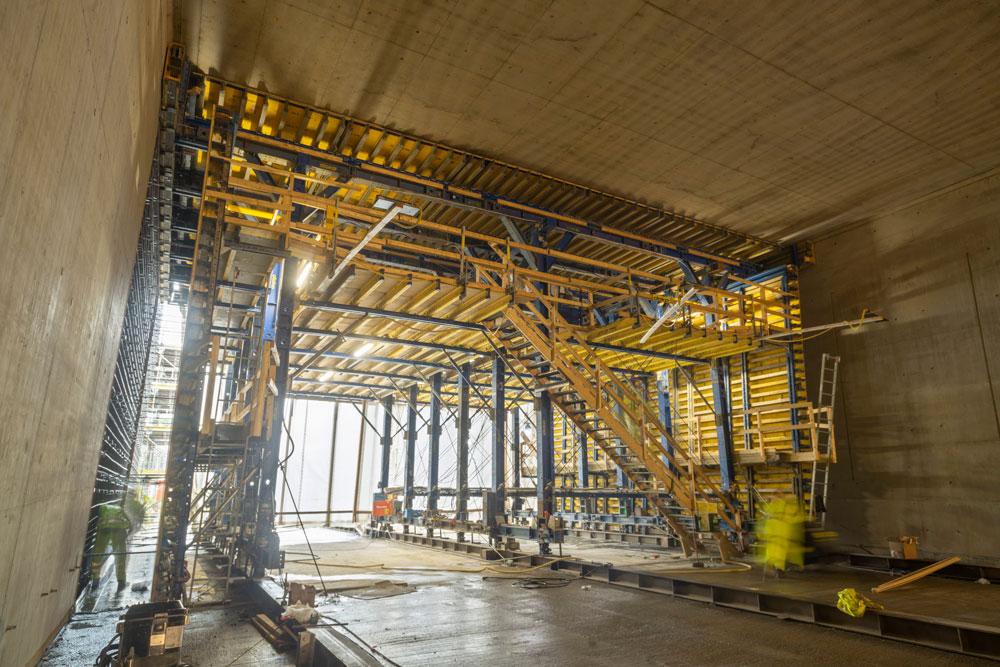DOKA Formwork enables Sweden’s biggest road and tunnel project
A 21 km motorway bypass is being constructed to relieve traffic in Stockholm: E4 Bypass Stockholm, or in Swedish “E4 Förbifart Stockholm.” The bypass, scheduled for completion by 2030 doesn’t just stand out as one of Sweden’s biggest infrastructure projects: its 18 kilometres of tunnel will make it the second-longest underground tunnel in city buildings. Doka is providing the formwork equipment for four project sections.
Stockholm is growing astonishingly fast – in fact, the Swedish capital has the fastest growth rate in Europe. The 14 islands that make up the Stockholm region are currently home to over a fifth of the Swedish population, with 2.1 million inhabitants. By 2030, this is expected to grow to around 2.5 million.

For the region to continue to develop, well-functioning infrastructure is essential, and major investments are being made in Stockholm. For example, local public transport has been improved by a new railway through Stockholm’s central districts, the Citybanan, which was officially opened in 2017. Although the Citybanan represents an important step towards improving public transport systems, it is not sufficient to combat the increasing car traffic in the city.
Stockholm currently only has one major road artery, Essingeleden. The road was opened in 1967 and is designed for 80,000 vehicles per day. Fifty years later, it is travelled by around 160,000 vehicles on a typical working day – and rising. Consequently, the transport system in Stockholm is extremely vulnerable, with Essingeleden in particular very sensitive to road accidents. To address this situation, a 21 km motorway is being constructed that will link the south of the city (Skärholmen) with the north (Häggvik). The new road, “E4 Bypass Stockholm”, will divert traffic away from the city centre to the west.

One of the longest road tunnels in the world
Most of the bypass – 18 of the 21 kilometres – will run through tunnels, making the bypass the world’s second-longest urban road tunnel, runner-up only to Tokyo’s Yamate Tunnel. The link will consist of twin tunnels, with its deepest point beneath lake Mälaren lying almost 70 m below sea level.
Each tunnel will have three lanes of traffic in each direction, supporting an anticipated traffic flow of 140,000 vehicles daily. During the construction work, 22 million tonnes of rock had to be excavated. Doka Sweden won the contract to provide formwork to four sections; FSE105 Kungens Kurva (King’s Curve), FSE502 Hjulsta Norra (North of Hjulsta), FSE61 Akalla and FSE62 Häggvik.

FSE105 Kungens Kurva (King’s Curve)
Workign with the client, Skanska, the King’s Curve Interchange is the largest of the four contracts. The project includes a traffic area with a roundabout bridge and ramps, a concrete trough 350 meters long and two concrete tunnels 330 meters long.
- FSE105 Kungens Kurva
- Rock excavations: 300,000 m³
- Soil excavations: 375,000 m³
- Concrete: 78,000 m³
- Sheet pile: 14,500 m²
- Concrete tunnels: 2 x 330m
- Formwork in use
- Framax Xlife
- Framax Xlife plus
- Large-area formwork Top 50
- Load-bearing tower Staxo 40
- Load-bearing tower Staxo 100
- Formwork traveller

FSE502 Hjulsta Norra (North of Hjulsta)
Workgin with NCC, the section FSE502 “North of Hjulsta”, where European Routes E4 and E18 meet, will be one of Sweden’s most important interchanges. The project section includes a 200 m concrete tunnel, and our challenge was to supply two formwork travellers that could be used to concrete the walls and ceiling simultaneously. The client also wanted to be able to move the travellers once a week. To achieve this, the travellers were fitted with hydraulic systems that could be used to complete the formwork work rapidly and logically.
- FSE502 North of Hjulsta
- Construction method: partially monolithic
- Tunnel with formwork: 2 x 370 m
- Length of concrete sections: 10 m
- Number of concrete sections: 2 x 38
- Trough: 170 m
- Formwork in use
- Framax Xlife
- Frami
- Top 50
- Staxo 100
- Formwork traveller

FSE61 Akalla and FSE62 Häggvik
Working with Züblin Scandinavia AB & NCC, an elliptical flyover is being built in Akalla above the local Stockholm traffic. This project section includes construction of around 950 m of motorway, major shoring measures for the excavation work, a tunnel around 120 m long built using the cut-and-cover method, the 480 m cutting for the tunnel entrance, and a roundabout. Work for the tunnel and cutting meets extensive specifications for impermeability and anchoring.
Construction from Häggvik towards the flyover is progressing through a deep rock gorge alongside the Hansta nature reserve. The work is being carried out in a highly challenging traffic environment, where access for traffic must be guaranteed at all times. On average, over 100,000 vehicles pass the site each day.
- FSE61 Akalla: data
- Concrete: 60,000 m³
- Reinforcement: 11,600 t
- Soil and Rock excavation: 715,000 m³
- Rock tunnel excavation: 11,100 m³
- Sheet pile: 8,745 m²
- FSE62 Häggvik: data
- Rock excavations: 320,000 m³
- Soil excavations: 250,000 m³
- Sheet pile: 3,500 m²
- Concrete: 29,000 m³
- Formwork in use
- Frami
- Framax Xlife
- Top 50
- Staxo 100
- Formwork traveller





















